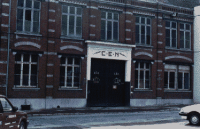Constructions Électriques du Nord: Difference between revisions
No edit summary |
No edit summary |
||
| (13 intermediate revisions by the same user not shown) | |||
| Line 1: | Line 1: | ||
{{Infobox manufacturer|hq=Tourcoing, HDF|key_people=<div>François Odoux-Lefebvre</div>|products=<div>Outdoor warning sirens</div> | {{Infobox manufacturer|hq=Tourcoing, HDF|key_people=<div>François Odoux-Lefebvre</div>|products=<div>Outdoor warning sirens</div> | ||
<div>Electric motors</div>|founded=<div>1885 | <div>Electric motors</div>|founded=<div>1885 | ||
<div>1897|image=CEN headquarters.png|caption=1 of CEN's buildings in 1989. Photo courtesy of Philip Gosse.|succeeded=[[Moteurs FOX|FOX Motors]]|title=<div>Northern Electrical Constructions</div> | <div>1897|image=CEN headquarters.png|caption=1 of CEN's buildings in 1989. Photo courtesy of Philip Gosse.|succeeded=<div>[[Moteurs FOX|FOX Motors]] | ||
<div>[[KMsecur|KM Europ]]|title=<div>Northern Electrical Constructions</div> | |||
---- | ---- | ||
<div>Constructions Électriques du Nord</div>}}'''Northern Electrical Constructions''' (French: ''Constructions Électriques du Nord''; abbreviated '''CEN'''), was a manufacturer of electrical machinery such as motors, generators, and outdoor warning sirens founded in 1897. CEN was one of the earliest manufacturers of sirens in France, producing them at least since 1926, and even after the company's closure, their sirens are a common sight in France. | <div>Constructions Électriques du Nord</div>|defunct=1986}}'''Northern Electrical Constructions''' (French: ''Constructions Électriques du Nord''; abbreviated '''CEN'''), was a manufacturer of electrical machinery such as motors, generators, and outdoor warning sirens founded in 1897. CEN was one of the earliest manufacturers of sirens in France, producing them at least since 1926, and even after the company's closure, their sirens are a common sight in France. | ||
== History == | == History == | ||
Constructions Électriques du Nord was founded at the turn of the 19th century in 1897, with 1 source suggesting they were founded even earlier in 1885<ref>http://pgosse.chez.com/CEN.htm</ref>. CEN started as little more than a small electrical machine shop, producing small motors which would power formerly steam-driven wool mills. The company's operations grew in size and scope during the 1900s, and the outbreak of World War I likely saw an increase in CEN's manufacturing capabilities. | Constructions Électriques du Nord was founded at the turn of the 19th century in 1897, with 1 source suggesting they were founded even earlier in 1885<ref>http://pgosse.chez.com/CEN.htm (in French)</ref>. CEN started as little more than a small electrical machine shop, producing small motors which would power formerly steam-driven wool mills. The company's operations grew in size and scope during the 1900s, and the outbreak of World War I likely saw an increase in CEN's manufacturing capabilities. | ||
Contrary to what some believe, CEN did not produce air raid sirens during World War I, with the only known manufacturers of sirens at the time being [[CICCA]] and [[Chollet]], of which very little are known about. CEN's sirens came at a much later date in 1926, when the company began to produce various models of outdoor warning sirens under François Odoux's direction, the CEO of the company at the time. CEN produced sirens from then until its closure, with units hailing from the 1980s to support this claim. Production of CEN's sirens during the 1940s likely continued to increase during World War II, with high demand for sirens to warn the public of Axis air raids. | |||
Though little is known about CEN, they were one of the most influential siren manufacturers | After the war, Odoux saw an opportunity to improve the primitive state of individual controls for small machines, with many at the time still controlled by pulley devices and belt transmissions. He founded FOX Motors in 1949, which complemented CEN's manufacturing and focused on fractional horsepower motors. FOX Motors began to produce sirens of their own in 1964, named the MONICA and PAKITA. The latter became predominant in the market, and competed with CEN's own NP2S and NP3S, despite Odoux's intention with FOX Motors to not compete with CEN at all. CEN began to produce brand new brushless AC motors begun in the early 1970s, as well as waterproof motors specifically built for a "UNITEC"'s water pumps, who later licensed their design to the American firm WEMCO. | ||
Unfortunately, CEN had closed up shop by 1986, and became KM Europ, who carried over CEN's designs and model naming scheme. KM Europ as an independent company now no longer exists; it was later acquired by Finescur in 2006, who still produces CEN's sirens under the [[KMsecur]] name, and was split with Moflash in 2018, although Moflash's portion of KM Europ does not produce outdoor warning sirens. Though little is known about CEN, they were one of the most influential siren manufacturers in France during the 20th century; despite the company being long gone, CEN sirens are one of, if not the most common sirens in France's nationwide siren system. Today, [[Moteurs FOX|FOX Motors]] continues CEN's legacy with their still manufactured PAKITA series of sirens, derived from CEN's models. | |||
== Products == | == Products == | ||
=== Type NP2S === | === Type NP2S === | ||
[[File:NP2S.jpg|thumb| | [[File:NP2S.jpg|thumb|160x160px|A Type NP2S unit. Photo courtesy of TheOfficialDorianelevator.|left]] | ||
The '''Type NP2S''' consists of an 8 or 10-port rotor and stator, with 10-port units being exceptionally rare. 8 (or 10) conical horns are attached to each stator port, which likely improves the sirens' audible range. A few units only have 6 horns, despite the siren having 8 ports. Some units have horns with mesh screens installed to prevent debris from entering, while others do not; whether this is because they never came with them or the mesh screens have fallen off or degraded is unknown. The horns are offset with the angle of the ports, which is typical for most French sirens produced post-WWII. The Type NP2S was also available without horns, leaving only the horn connecting pieces attached to the stator and mesh screens covering the openings. The Type NP2S is driven by a 50/60 Hz 2.2 kW (3 hp) 3 ph 230/400 V motor above the stator, which spins the rotor at around 2850 rpm. It is unknown if 1 ph units were ever offered. Some units have cylindrical plates suspended above the motor by several supports, which shields | The '''Type NP2S''' consists of an 8 or 10-port rotor and stator, with 10-port units being exceptionally rare. 8 (or 10) conical horns are attached to each stator port, which likely improves the sirens' audible range. Whether the 10-port units are genuine Type NP2Ss or another product of CEN entirely is unclear. A few units only have 6 horns, despite the siren having 8 ports. Some units have horns with mesh screens installed to prevent debris from entering, while others do not; whether this is because they never came with them, or the mesh screens have fallen off or degraded is unknown. The horns are offset with the angle of the ports, which is typical for most French sirens produced post-WWII. | ||
The Type NP2S was also available without horns, leaving only the horn connecting pieces attached to the stator and mesh screens covering the openings. A good number of units, assuming they are Type NP2Ss, feature a rotor-over-motor configuration, having a large conical shroud of varying size and shape suspended above the stator shielding the siren from the elements. The Type NP2S is driven by a 50/60 Hz 2.2 kW (3 hp) 3 ph 230/400 V motor above the stator, which spins the rotor at around 2850 rpm. It is unknown if 1 ph units were ever offered. The motors utilized on the Type NP2S are taller and fan cooled, unlike the Type NP3S's which is shorter and lacks a fan; this is currently the only way to differentiate the 2, aside from looking at the tags bolted to the motors. | |||
The Type NP2S was also able to be equipped with a gearbox which would speed up the motor tremendously, with the rotor on these units clocking in at around 4400 rpm, twice the speed of most standard French sirens. Some units have cylindrical plates suspended above the motor by several supports, which shields the motor from the elements. A cylindrical assembly with a mesh screen wrapped around it serves as the siren's intake. This design was later carried over to KM Europ after CEN went defunct, who seemingly only rebadged the siren and made no other changes. CEN and KM Europ-era units are relatively identical, and the same can be said for units produced once KM Europ became KMfinescur. Despite the difference between the 2 sirens being relatively minimal, the Type NP2S was not nearly as successful as the Type NP3S; comparatively less Type NP2S units exist compared to Type NP3Ss. | |||
=== Type NP3S === | === Type NP3S === | ||
[[File:NP3S.jpg|thumb| | [[File:NP3S.jpg|thumb|160x160px|A Type NP3S unit. Photo courtesy of TheOfficialDorianelevator.]] | ||
The '''Type NP3S''' consists of an 8 or 10-port rotor and stator, with 10-port units being exceptionally rare. 8 (or 10) conical horns are attached to each stator port, which likely improves the sirens' audible range. Some units have horns with mesh screens installed to prevent debris from entering, while others do not; whether this is because they never came with them or the mesh screens have fallen off or degraded is unknown. The horns are offset with the angle of the ports, which is typical for most French sirens produced post-WWII. The Type NP3S was also available without horns, leaving only the horn connecting pieces attached to the stator and mesh screens covering the openings. The Type NP3S is driven by a 50/60 Hz | The '''Type NP3S''' consists of an 8 or 10-port rotor and stator, with 10-port units being exceptionally rare. 8 (or 10) conical horns are attached to each stator port, which likely improves the sirens' audible range. Whether the 10-port units are genuine Type NP3Ss or another product of CEN entirely is unclear. Some units have horns with mesh screens installed to prevent debris from entering, while others do not; whether this is because they never came with them, or the mesh screens have fallen off or degraded is unknown. The horns are offset with the angle of the ports, which is typical for most French sirens produced post-WWII. [[File:NP3S Gearbox.jpg|thumb|160x160px|A Type NP3S unit equipped with a gearbox. Photo courtesy of TheOfficialDorianelevator.|left]]The Type NP3S was also available without horns, leaving only the horn connecting pieces attached to the stator and mesh screens covering the openings. A good number of units, assuming they are Type NP3Ss, feature a rotor-over-motor configuration, having a large conical shroud of varying size and shape suspended above the stator shielding the siren from the elements. The Type NP3S is driven by a 50/60 Hz motor above the stator (with exact details unknown), which spins the rotor at around 2850 rpm. It is unknown if 1 ph units were ever offered. The motors utilized on the Type NP3S are shorter and lack a fan, unlike the Type NP3S's which is taller and fan cooled; this is currently the only way to differentiate these sirens, aside from looking at the tags bolted to the motors. | ||
The Type NP3S was also able to be equipped with a gearbox which would speed up the motor tremendously, with the rotor on these units clocking in at around 4400 rpm, twice the speed of most standard French sirens. Some units have cylindrical plates suspended above the motor by several supports, which shields the motor from the elements. A cylindrical assembly with a mesh screen wrapped around it serves as the siren's intake. This design was later carried over to KM Europ after CEN went defunct, who seemingly only rebadged the siren and made no other changes. CEN and KM Europ-era units are relatively identical, and the same can be said for units produced once KM Europ became KMfinescur. Despite the difference between the 2 sirens being relatively minimal, the Type NP3S was the more successful of the 2, with a majority of CEN sirens being Type NP3Ss. | |||
=== Double motor/Double speed sirens === | |||
[[File:CENdamper.jpg|thumb|240x240px|A (now replaced) 9-port "double motor" siren in Montataire, HDF, apparently equipped with a damper mechanism.]] | |||
[[File:CEN Double speed.png|thumb|160x160px|A 10-port "double speed" siren with a rotor-on-top configuration.|left]] | |||
CEN produced several other models of sirens, none of which have known model names. These all share similar designs, with several unique aspects and variants. An example of these would be their '''double motor'''<ref>This name is slightly misleading; these sirens do not have 2 motors, but instead utilize the pre-existing motor as well as a gearbox.</ref>/'''double speed sirens''' (both nicknames coined by enthusiasts), which came standard in 9 or 10-port, with conical horns are attached to each stator port. Some units have horns with mesh screens installed to prevent debris from entering, while others do not; whether this is because they never came with them, or the mesh screens have fallen off or degraded is unknown. The horns are offset with the angle of the ports, which is typical for most French sirens produced post-WWII. | |||
These sirens came standard with a gearbox to speed the motors up. As expected, the rotors of these spin quite fast, at around 4400 (for the double motor sirens) and 3750 (for the double speed sirens) rpm. This is about twice as fast as most standard French sirens, thus the "double motor"/double speed" name. Both are relatively identical, with the only differences being variations in the motors used. At least 1 of these sirens was also equipped with some sort of damper mechanism. With a few exceptions, most of these sirens had their motors below the stator as opposed to on top of it like the Type NP sirens, with units with their motors on the bottom having a large conical shroud of varying size and shape suspended above the stator shielding the siren from the elements. It is unknown when exactly these were produced, and few of them exist. | |||
== References == | == References == | ||
Latest revision as of 01:02, 12 November 2024
Northern Electrical Constructions (French: Constructions Électriques du Nord; abbreviated CEN), was a manufacturer of electrical machinery such as motors, generators, and outdoor warning sirens founded in 1897. CEN was one of the earliest manufacturers of sirens in France, producing them at least since 1926, and even after the company's closure, their sirens are a common sight in France.
History
Constructions Électriques du Nord was founded at the turn of the 19th century in 1897, with 1 source suggesting they were founded even earlier in 1885[1]. CEN started as little more than a small electrical machine shop, producing small motors which would power formerly steam-driven wool mills. The company's operations grew in size and scope during the 1900s, and the outbreak of World War I likely saw an increase in CEN's manufacturing capabilities.
Contrary to what some believe, CEN did not produce air raid sirens during World War I, with the only known manufacturers of sirens at the time being CICCA and Chollet, of which very little are known about. CEN's sirens came at a much later date in 1926, when the company began to produce various models of outdoor warning sirens under François Odoux's direction, the CEO of the company at the time. CEN produced sirens from then until its closure, with units hailing from the 1980s to support this claim. Production of CEN's sirens during the 1940s likely continued to increase during World War II, with high demand for sirens to warn the public of Axis air raids.
After the war, Odoux saw an opportunity to improve the primitive state of individual controls for small machines, with many at the time still controlled by pulley devices and belt transmissions. He founded FOX Motors in 1949, which complemented CEN's manufacturing and focused on fractional horsepower motors. FOX Motors began to produce sirens of their own in 1964, named the MONICA and PAKITA. The latter became predominant in the market, and competed with CEN's own NP2S and NP3S, despite Odoux's intention with FOX Motors to not compete with CEN at all. CEN began to produce brand new brushless AC motors begun in the early 1970s, as well as waterproof motors specifically built for a "UNITEC"'s water pumps, who later licensed their design to the American firm WEMCO.
Unfortunately, CEN had closed up shop by 1986, and became KM Europ, who carried over CEN's designs and model naming scheme. KM Europ as an independent company now no longer exists; it was later acquired by Finescur in 2006, who still produces CEN's sirens under the KMsecur name, and was split with Moflash in 2018, although Moflash's portion of KM Europ does not produce outdoor warning sirens. Though little is known about CEN, they were one of the most influential siren manufacturers in France during the 20th century; despite the company being long gone, CEN sirens are one of, if not the most common sirens in France's nationwide siren system. Today, FOX Motors continues CEN's legacy with their still manufactured PAKITA series of sirens, derived from CEN's models.
Products
Type NP2S
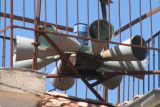
The Type NP2S consists of an 8 or 10-port rotor and stator, with 10-port units being exceptionally rare. 8 (or 10) conical horns are attached to each stator port, which likely improves the sirens' audible range. Whether the 10-port units are genuine Type NP2Ss or another product of CEN entirely is unclear. A few units only have 6 horns, despite the siren having 8 ports. Some units have horns with mesh screens installed to prevent debris from entering, while others do not; whether this is because they never came with them, or the mesh screens have fallen off or degraded is unknown. The horns are offset with the angle of the ports, which is typical for most French sirens produced post-WWII.
The Type NP2S was also available without horns, leaving only the horn connecting pieces attached to the stator and mesh screens covering the openings. A good number of units, assuming they are Type NP2Ss, feature a rotor-over-motor configuration, having a large conical shroud of varying size and shape suspended above the stator shielding the siren from the elements. The Type NP2S is driven by a 50/60 Hz 2.2 kW (3 hp) 3 ph 230/400 V motor above the stator, which spins the rotor at around 2850 rpm. It is unknown if 1 ph units were ever offered. The motors utilized on the Type NP2S are taller and fan cooled, unlike the Type NP3S's which is shorter and lacks a fan; this is currently the only way to differentiate the 2, aside from looking at the tags bolted to the motors.
The Type NP2S was also able to be equipped with a gearbox which would speed up the motor tremendously, with the rotor on these units clocking in at around 4400 rpm, twice the speed of most standard French sirens. Some units have cylindrical plates suspended above the motor by several supports, which shields the motor from the elements. A cylindrical assembly with a mesh screen wrapped around it serves as the siren's intake. This design was later carried over to KM Europ after CEN went defunct, who seemingly only rebadged the siren and made no other changes. CEN and KM Europ-era units are relatively identical, and the same can be said for units produced once KM Europ became KMfinescur. Despite the difference between the 2 sirens being relatively minimal, the Type NP2S was not nearly as successful as the Type NP3S; comparatively less Type NP2S units exist compared to Type NP3Ss.
Type NP3S
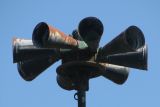
The Type NP3S consists of an 8 or 10-port rotor and stator, with 10-port units being exceptionally rare. 8 (or 10) conical horns are attached to each stator port, which likely improves the sirens' audible range. Whether the 10-port units are genuine Type NP3Ss or another product of CEN entirely is unclear. Some units have horns with mesh screens installed to prevent debris from entering, while others do not; whether this is because they never came with them, or the mesh screens have fallen off or degraded is unknown. The horns are offset with the angle of the ports, which is typical for most French sirens produced post-WWII.

The Type NP3S was also available without horns, leaving only the horn connecting pieces attached to the stator and mesh screens covering the openings. A good number of units, assuming they are Type NP3Ss, feature a rotor-over-motor configuration, having a large conical shroud of varying size and shape suspended above the stator shielding the siren from the elements. The Type NP3S is driven by a 50/60 Hz motor above the stator (with exact details unknown), which spins the rotor at around 2850 rpm. It is unknown if 1 ph units were ever offered. The motors utilized on the Type NP3S are shorter and lack a fan, unlike the Type NP3S's which is taller and fan cooled; this is currently the only way to differentiate these sirens, aside from looking at the tags bolted to the motors.
The Type NP3S was also able to be equipped with a gearbox which would speed up the motor tremendously, with the rotor on these units clocking in at around 4400 rpm, twice the speed of most standard French sirens. Some units have cylindrical plates suspended above the motor by several supports, which shields the motor from the elements. A cylindrical assembly with a mesh screen wrapped around it serves as the siren's intake. This design was later carried over to KM Europ after CEN went defunct, who seemingly only rebadged the siren and made no other changes. CEN and KM Europ-era units are relatively identical, and the same can be said for units produced once KM Europ became KMfinescur. Despite the difference between the 2 sirens being relatively minimal, the Type NP3S was the more successful of the 2, with a majority of CEN sirens being Type NP3Ss.
Double motor/Double speed sirens
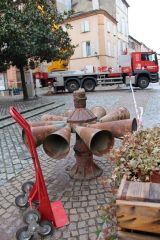
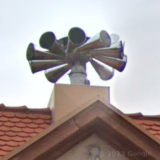
CEN produced several other models of sirens, none of which have known model names. These all share similar designs, with several unique aspects and variants. An example of these would be their double motor[2]/double speed sirens (both nicknames coined by enthusiasts), which came standard in 9 or 10-port, with conical horns are attached to each stator port. Some units have horns with mesh screens installed to prevent debris from entering, while others do not; whether this is because they never came with them, or the mesh screens have fallen off or degraded is unknown. The horns are offset with the angle of the ports, which is typical for most French sirens produced post-WWII.
These sirens came standard with a gearbox to speed the motors up. As expected, the rotors of these spin quite fast, at around 4400 (for the double motor sirens) and 3750 (for the double speed sirens) rpm. This is about twice as fast as most standard French sirens, thus the "double motor"/double speed" name. Both are relatively identical, with the only differences being variations in the motors used. At least 1 of these sirens was also equipped with some sort of damper mechanism. With a few exceptions, most of these sirens had their motors below the stator as opposed to on top of it like the Type NP sirens, with units with their motors on the bottom having a large conical shroud of varying size and shape suspended above the stator shielding the siren from the elements. It is unknown when exactly these were produced, and few of them exist.
References
- ↑ http://pgosse.chez.com/CEN.htm (in French)
- ↑ This name is slightly misleading; these sirens do not have 2 motors, but instead utilize the pre-existing motor as well as a gearbox.
